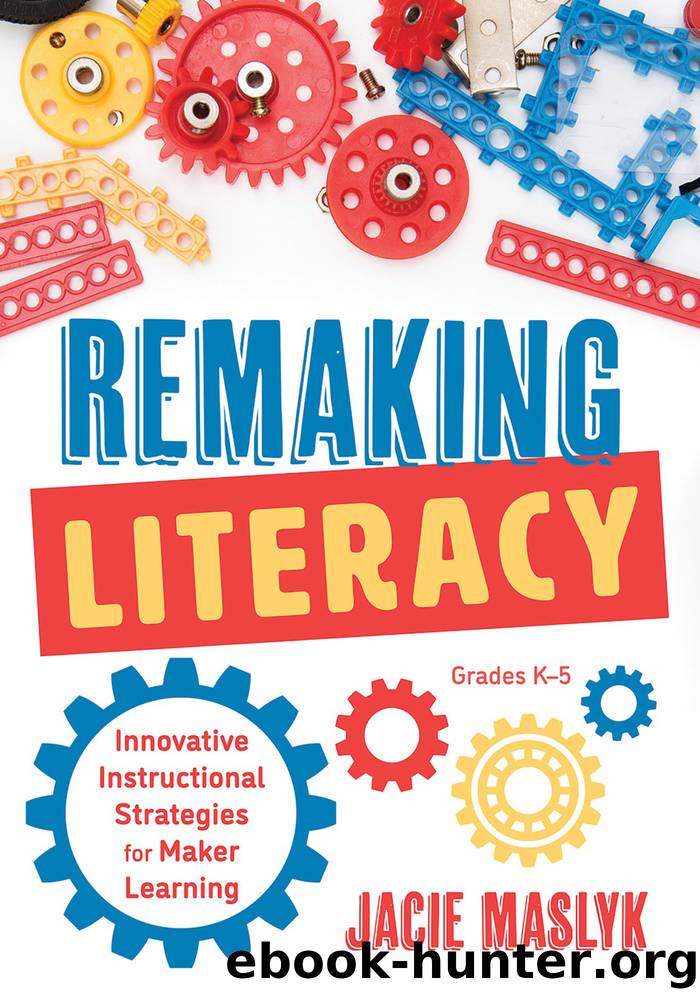Remaking Literacy by Maslyk Jacie;

Author:Maslyk, Jacie;
Language: eng
Format: epub
Publisher: Solution Tree
Published: 2019-08-15T00:00:00+00:00
Conclusion
Utilizing thinking and design strategies is another step toward remaking literacy practices that builds increased student engagement and excitement for learning, and perhaps a little positive chaos too. Thinking and learning in classrooms that implement these strategies looks different than teachers may be used to. Instead of quiet classrooms where students are seated, students will be talkingâmaybe loudlyâand walking around the classroom, doodling, or using another physical strategy that helps them to process their thinking and make meaning of what they are learning. These are all good things, but some teachers may hesitate to try these strategies because doing so requires letting go of control and turning the learning over to the students. One teacher admitted to me, âGiving my students materials to tinker with while I was reading a story aloud was a huge risk for me! I really had to trust that they were going to use the hands-on approach to add to their learning and not detract from it.â Itâs true that when you allow students to make choices, think, and express themselves, you never know whatâs going to happen. Implementing thinking practices opens the lesson up to the unpredictability of the minds of your students. It can be scary for teachers to accept they are no longer in control of the learning. However, we have to take the steps to let our students wonder about new ideas and show their thinking in different ways. We need to infuse design into our practices so students can gain experience with critical skills like creativity, collaboration, problem solving, and perseverance.
MINDS ON MAKING
Reflect on the following three questions for professional development or personal reflection.
1. How might you incorporate creative notetaking in your class?
2. In what ways do you encourage students to make their thinking visible to others?
3. Designing for others builds empathy and understanding. How will you invite students to design within the literacy classroom?
Download
This site does not store any files on its server. We only index and link to content provided by other sites. Please contact the content providers to delete copyright contents if any and email us, we'll remove relevant links or contents immediately.
Macmillan Primary Grammar 2 Pupil's Book by Unknown(378)
Figuring Out Fluency in Mathematics Teaching and Learning, Grades K-8 by Jennifer M. Bay-Williams & John J. SanGiovanni(342)
The Principal's Guide to Curriculum Leadership by Sorenson Richard D.;Goldsmith Lloyd M.;Mendez Zulma Y.;Maxwell Karen T.;(266)
English Grammar Practice--The Noun by Roxana Nastase(228)
Learning from Accidents 3rd ed by Trevor Kletz (2001)(226)
Harnessing Technology for Deeper Learning by Scott McLeod(215)
Text-Dependent Questions, Grades K-5 by Douglas Fisher & Nancy Frey & Heather Anderson & Marisol Thayre(208)
A Guide to Curriculum Mapping by Hale Janet A.;(202)
English Language Program Administration by Unknown(199)
Deep Change Leadership by Reeves Douglas;(190)
How to Do Everything with Google Tools by Unknown(188)
The Grammar Teacher's Activity-a-Day by Jack Umstatter(178)
The Power of SMART Goals by Conzemius Anne;O'Neill Jan; & Anne Conzemius(175)
Beyond the RTI Pyramid by Bender William N.;(158)
Aligning and Balancing the Standards-Based Curriculum by Squires David A.;(156)
Using Data to Close the Achievement Gap by Johnson Ruth S.;(156)
Using Equity Audits to Create Equitable and Excellent Schools by Skrla Linda E.;McKenzie Kathryn B.;Scheurich James Joseph;(151)
Differentiated Instructional Strategies for the Block Schedule by Gregory Gayle H.;Herndon Lynne E.; & Lynne E. Herndon(145)
You've Got to Reach Them to Teach Them by Schreck Mary Kim; & Schreck(140)
